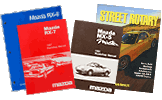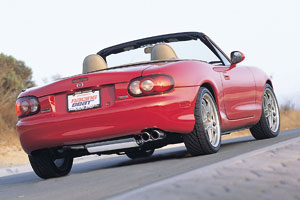
Miata Exhaust Systems
Select the exhaust for your Miata:
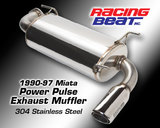
Power Pulse Muffler
90-97 Miata
Designed and manufactured by Racing Beat, our Power Pulse Muffler is intended for use on all 1990-1997 Miatas. The ... ![]()
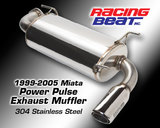
Power Pulse Miata Muffler
99-05 Miata
Racing Beat Power Pulse Muffler
1999-2005 Miata (All) - Except 1999-... ![]()
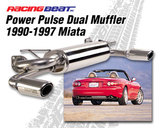
Power Pulse Dual Outlet Muffler
90-97 Miata
Our Racing Beat Power Pulse Dual Outlet Exhaust project was originally started after a request by Mazda USA for a ... ![]()
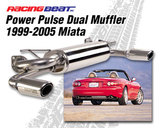
Power Pulse Dual Outlet Muffler
99-05 Miata
1999-2003 Miata (manual transmission) & 2004-2005 Miata (except Mazdaspeed) - Our Racing Beat Power Pulse Dual ... ![]()

Power Pulse Dual Outlet Muffler - Auto Trans
99-03 Miata
Our Racing Beat Power Pulse Dual Outlet Exhaust project was originally started after a request by Mazda USA for a ... ![]()
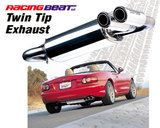
Power Pulse Twin Tip Muffler
99-05 Miata
Applications: 1999-03 Miata (except auto transmission models) & 2004-2005 Miata (... ![]()

Power Pulse Twin Tip Muffler - Auto Trans
99-03 Miata
Applications: 1999-03 Miata (except manual transmission models) & 2004-2005 Miata (... ![]()
One of the more popular upgrades that many Miata owners consider is the replacement of an old stock exhaust system with a high performance aftermarket system, and for good reason. Not only do they look and sound great but they can also release a few lost horsepower that were bottled-up in the stock system. Now, let's be fair to the auto manufacturers; they need to develop an exhaust system that both produces adequate power and has an exhaust note that will appeal to the average consumer. On both levels they've succeeded.
Although this approach may work for someone driving a commuter vehicle, the Miata really should sound a bit more "sporty", right? Since you're reading this article you're most likely someone who is interested in upgrading the exhaust on your Miata to improve the sound, appearance, and performance. So, with the hundreds of exhaust systems on the market, just which one should you chose for your Miata?
Exhaust System Configurations
If you own a 1990-97 Miata your selection of a replacement muffler will most likely be a two-piece assembly. Although the stock muffler on your Miata is a long single unit, aftermarket manufacturers must divide their mufflers into two (2) parts (muffler & connecting-pipe sections) for shipping reasons. The muffler section can typically feature either a single outlet tip similar to stock or, for a more exotic look, dual outlet systems (left and right side tips) or twin tips (two outlet tips on the same side) are available. The connecting-pipe sections may contain a single presilencer section for improved noise suppression, or the presilencer can be eliminated for a lighter-weight, more aggressive sounding exhaust. On the later 1990-2005 Miatas the most common replacement option is a rear muffler section only. Although you can upgrade the connecting-pipe section on the 1999-2005 Miata, this section contains a catalytic converter and emissions issues may be a concern. (If are considering upgrading the connecting-pipe section on the 1999-2005 Miata you may want to contact your local emissions testing authorities, if applicable, for more information.) Both the 1990-97 two-piece exhaust and the 1999-2005 replacement mufflers are considered “emissions legal”. However, your state may impose noise limitations for aftermarket exhaust systems, so check with your local governmental agencies if this is a concern.

Many aftermarket systems feature either slip-joint or flanged pipe connections on the tubing sections. Slip-joint connections are typically used where space is limited or as a cost-saving measure for the manufacturer. This type of joint utilizes a clamp device to secure the tubing sections and may not seal the tubing sections adequately, resulting in exhaust gas leaks. A flanged pipe section offers the benefit of a very secure fitment, correct alignment of the muffler tip in the bumper opening, and minimal possibility of an exhaust gas leak. Many of the newer flange designs feature smaller donut shaped gaskets that are trapped within a recessed area of the flange and offer a superior sealing.
Construction materials have become standardized over the years with 304 stainless steel canisters, tubing, and flanges becoming the industry standard for most aftermarket exhaust systems. All tubing should utilize mandrel-bending processes to provide smooth, constant radius bends. Internal muffler designs typically feature a straight-through design for superior exhaust gas flow and reduced back pressure depending on the specific engine application and sound level output of that engine. Tubing diameters range from 2" on a conservative OE-type replacement to a 2.25" to 2.375" OD for a non-turbo sport performance exhaust. For turbo applications, larger 2.5" or 2.75" OD tubing can be used to further lessen exhaust backpressure, resulting in improved turbo performance. While this larger diameter tubing might allow an unpleasant exhaust noise to pass through the exhaust system in a normally aspirated car, the turbocharger unit acts as a very good presilencer - reducing much of the high frequency noise that would otherwise pass through to the presilencer and muffler sections.

Performance Gains
A primary consideration when evaluating a replacement exhaust is the performance gains can be expected for their Miata. On a well-designed aftermarket system you should reasonably expect a 3-4 HP gain from 1990-97 Miata cat-back system, and slightly less for a 1999-2005 Miata muffler replacement. Our repeated dyno-testing over the years has revealed that Mazda's engineering team has designed an efficient OE exhaust system, and obtaining large performance gains from an aftermarket system simply isn't possible. If you see what appears to be overstated HP gains for a particular system you're considering, be a wary consumer and ask yourself "why would Mazda's engineers leave this much untapped HP behind in an inefficient exhaust design?" If it's too good to believe, it probably isn't true.
Selecting The Best System For Your Miata
So now that you have some background on exhaust systems for your Miata, which system is the correct system for your car? Great question, but only you can answer it. Take a step back for a moment and ask yourself what are your expectations from an exhaust system for your car. Do you use your car as a daily-driven car and enjoy listening to talk radio or classical music on your way to the office each day? If so, a loud exhaust system would probably not be your ideal choice. If you typically take a spouse or car-pool friend along on your trips then the same logic applies. However, if you don't mind a bit more attitude from your exhaust and like a more aggressive exhaust tone during acceleration and downshifting - then you have a wide range of choices available to you. As you probably noticed by now, there are many exhaust systems on the market that feature hype and fluffy advertising copy but offer little information regarding just how a specific exhaust system will sound on your car. Adding to the complexity is the fact that is a very subjective issue; what you like may be very different from what someone else prefers. If you're not certain of just how loud you want to go, edge towards the conservative side and consider a modest upgrade. You'd be surprised at the number of calls we receive from Miata owners that are looking to downgrade the noise level of an aftermarket exhaust system they've purchased - many times as the result of loudly protesting co-pilot spouse!
The most critical elements of the exhaust system sound and tone are the direct results of exhaustive research and testing. While many overseas exhaust systems may seem attractive due to a low price, shiny appearance, and a larger muffler tip, these systems may feature generic, standardized muffler components and the resulting exhaust tone may produce a harsh, buzzy or droning exhaust sound. Over the years we've heard from plenty of Miata owners that are searching for a bit more, eh-hem, "grown up" and mature sounding exhaust system than what these inexpensive systems offer.
The Racing Beat Approach
At Racing Beat the heart of every exhaust system is a Miata-tuned muffler canister. Each muffler canister we produce has been designed specifically for a particular engine and vehicle application. To moderate sound quality we can incorporate specially-designed internal ports, chambers, deflectors, or diverters that allow us to refine both the sound level and performance to meet our requirements. Once the muffler design has been finalized, we can then match the muffler to a presilencer section to further tune the engine exhaust tone if needed. Using the OE exhaust system as a guide, the replacement system is carefully hand-crafted using mandrel-bent tubing sections, stainless steel hangers and flanges, and a polished stainless muffler tip. Racing Beat systems may feature a combination of OE-supplied flanges and/or Racing Beat's own cast-stainless steel mounting flanges - both utilizing the latest in gas sealing qualities. The system is installed onto the car and test driven and dyno-tested to further evaluate the sound level output, tone, character and performance. If needed, changes can be made to the internal design of the muffler canister to isolate a specific frequency or pitch that may seem objectionable to our designers. Only after the design team is fully satisfied with the sound, performance, and appearance will these systems be produced and make it to bear the Racing Beat name.

So how will a Racing Beat exhaust system sound once installed on your car? For over 40 years we've prided ourselves on manufacturing exhaust systems that produce a deep, mellow, rich-sounding exhaust note. An exhaust system should sound exotic and exciting without sounding brash, harsh or buzzy. Upon acceleration the engine tone should jump to life with an exhilarating sound, but at cruising speeds the level should be moderate and mellow. All Racing Beat exhaust systems for the Miata have been designed to comply with California's 95 db sound level limit (recorded at ¾ maximum engine RPM - steady state). Once Miata owners install a Racing Beat exhaust system it's not uncommon for us to receive emails and phone calls with raves about the improvement in sound - both with the top and down! This applies to both the single and dual tip Racing Beat systems we offer, although the dual tip system does require some minor modification of the rear bumper to allow correct fitment of the additional muffler tip. (To review the installation instructions for this process, visit the product listing on the website.)
Another great source of information regarding exhaust sound and performance can be gathered from your local Miata club members. Consult with them regarding what they prefer on their vehicles, or visit a local weekend event to get an in-person listen or test drive. The Miata internet forums are another good source of Miata information, but many of these forum members may be slanted towards the more performance/racing side of the table - take their advice knowing that they may prefer something much louder and aggressive sounding than you might prefer! Check the web for video clips of their Miata with a Racing Beat exhaust system on board - we'll continue to update our video link section with good quality clips that we discovered ourselves.
We hope this article has answered many of your questions regarding the basics of the Miata replacement exhaust system. If you have more specific questions about the exhaust for your Miata we invite you to contact use directly.

